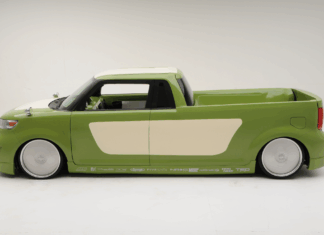Jeep invited us as the first group of media inside the Toledo North Assembly Plant since JL Wrangler production began.
We toured five main areas of Toledo North, and got too see some of the key processes involved in bringing the Wrangler to life.
With 204,269 Jeep Wranglers sold through October of 2018, the Jeep Wrangler is enjoying its best sales year ever, surpassing the record it set back in 2015.
ALSO SEE: Report: FCA Recalling 18,000 2018 and 2019 Jeep Wrangler Models Due to Potential Frame Weld Failures
Our tour began at what is the beginning and end of chassis assembly. Battery self-guided carts, or AGVs as they are called by Jeep, whiz by carrying fully assembled chassis to the end of the line on our left, while on the right, raw chassis’ are just beginning assembly.
Each one of the AGVs can travel as speeds of up to 120 feet per minute, and has a stopping accuracy within 0.25 inches. Each AGV can carry up to 3500 pounds.
The idea behind the entire line here at Toledo North is to present each part and process to the employees in the more ergonomically friendly way. Jeep tries to treat each line worker like a surgeon, maximizing their energy and time by eliminating movements from each process.
Next up, we saw the Robotic Frame Transfer robot, the largest industrial robot available anywhere in the world. It can lift up to 5,070 pounds and the robot itself weighs nearly 25,000 pounds. The robot can reach up to 12 feet, with an accuracy range within 0.0625 inches. Jeep says it’s easier to maintain this system than a traditional conveyor transfer system, while the robot can also accommodate different sizes of vehicle models easily thanks to infrared vision.
The next station is probably the most fun to watch, it’s called body and chassis decking, and it’s where the body meets the frame. The fully automated machine mates the two pieces, which are then secured with bolts that the machine fastens. The torque on each bolt is monitored and the machine is able to track exactly how the frame and body come together.
Next, we saw how the windshield are installed. Only one worker is required to place the windshields onto the machine, and then the robots take over. A robot lays down a bead of urethane that will be used to bond the window to its frame, and it does so with the exact same precision each time. But just in case, each window bead is checked by an infrared vision system, just to be sure.
On the way to the next station, we passed a long set of intertwined tracks, a section of line which allows Jeep to move a model ahead or behind in production. So if for some reason a huge order came in for Rubicon two-door models for example, Jeep is able to push hold other back and push through whichever model they need to. And don’t forget, there are 12 different frame variations of the Wrangler.
 And finally we made it to the Rotisserie Skillet. Because the Wrangler is a convertible, and also an off-road, special attention needs to be paid to both the roof and underside. That’s where the skillet makes things easy, by rotating each Jeep 90 degrees and bringing the work are right to the worker.
And finally we made it to the Rotisserie Skillet. Because the Wrangler is a convertible, and also an off-road, special attention needs to be paid to both the roof and underside. That’s where the skillet makes things easy, by rotating each Jeep 90 degrees and bringing the work are right to the worker.
This is not the entire assembly process, but this is as much as Jeep wanted to show us. So make sure you watch the full video above to see Toledo North in action!






























